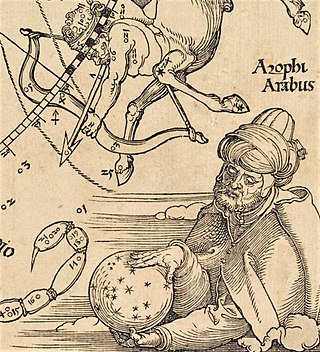Top Qs
Timeline
Chat
Perspective
Abd al-Rahman al-Sufi
Persian astronomer (903–986) From Wikipedia, the free encyclopedia
Remove ads
ʿAbd al-Raḥmān al-Ṣūfī (Persian: عبدالرحمن الصوفی; 7 December 903 – 25 May 986) was a Persian astronomer.[1][2] His work Kitāb ṣuwar al-kawākib ("The Book of Fixed Stars"), written in 964, included both textual descriptions and illustrations. The Persian polymath Al-Biruni wrote that al-Ṣūfī's work on the ecliptic was carried out in Shiraz. Al-Ṣūfī lived at the Buyid court in Isfahan.
Remove ads
Biography
ʿAbd al-Rahmān al-Ṣūfī (full name: Abū’l-Ḥusayn ʿAbd al-Raḥmān ibn ʿUmar ibn Sahl al-Ṣūfī al-Rāzī)[3] was one of the nine famous Muslim astronomers.[citation needed] He lived at the court of Emir 'Adud al-Dawla in Isfahan, and worked on translating and expanding ancient Greek astronomical works, especially the Almagest of Ptolemy. He made corrections to Ptolemy's star list, and his estimations of star brightness and magnitude deviated from those by Ptolemy; just over half of al-Ṣūfī's magnitudes being identical to Ptolemy's.[4] A Persian, al-Ṣūfī wrote in Arabic, the lingua franca of the scientific Muslim world.[5]
Al-Ṣūfī was a major contributor to the translation into Arabic of the Hellenistic astronomy that had been centered in Alexandria, Egypt. His was the first to attempt to relate the Greek with the traditional Arabic star names and constellations, which were completely unrelated and overlapped in complicated ways.[citation needed]
Remove ads
Astronomy
Summarize
Perspective
Al-Ṣūfī made his astronomical observations at a latitude of 32.7N° in Isfahan.[4] It has been claimed that he identified the Large Magellanic Cloud,[citation needed] but this seems to be a misunderstanding of a reference to some stars south of Canopus which he admits he has not seen.[6] He also made the earliest recorded observation of the Andromeda Galaxy in 964, describing it as a "small cloud".[7] This was the first galaxy other than the Milky Way to be mentioned in writing.[8]
Astrolabe
Al-Ṣūfī also wrote about the astrolabe, finding numerous additional uses for it: According to American Near Eastern scholar Adam L. Bean, Al-Ṣūfī's work reportedly described over 1000 different uses in areas as diverse as astronomy, astrology, horoscopes, navigation, surveying, timekeeping, Qibla and Salat prayer.[9][10]
Kitāb ṣuwar al-kawākib ("The Book of Fixed Stars")

Al-Ṣūfī published Kitāb ṣuwar al-kawākib ("The Book of Fixed Stars") in 964, and dedicated it to Adud al-Dawla, the ruler of Buwayhid at the time.[6] This book describes 48 constellations and the stars within them.[citation needed]
Al-Ṣūfī compared Greek constellations and stars as described in Ptolemy’s Almagest with Arabic ones,[12] linking those that were the same.[13][page needed] He included two illustrations of each constellation, one showing the orientation of the stars from the perspective outside the celestial globe, and the other from the perspective of looking at the sky while standing on the Earth. He separated them into three groups; 21 seen from the north, 15 seen from the south, and the 12 zodiac constellations. He included a complete set of star charts, that included the names and numbers of the individual stars in each of the 48 constellations, and each star's longitudinal and latitudinal coordinates, magnitude, and location north or south of the ecliptic.[6]
Scribal errors within the 35 surviving copies of The Book of Fixed Stars have caused the value of the magnitude for a particular star to vary from manuscript to manuscript.[14][page needed][15] Al-Ṣūfī organized the stars in each of his drawings into two groups: those that form the image depicted, and others that are in close proximity to the image. He identified and described stars not included by Ptolemy, but he did not include them in his own star charts. Stating that his charts were modelled after Ptolemy, he left the stars excluded in Ptolemy's catalogue out of his charts as well.[6]
To allow for the longitudinal placement of the stars within constellations having changed over the eight centuries since the Almagest was written, Al-Ṣūfī added 12° 42' to all the longitudes values provided by Ptolemy.[16] Al-Ṣūfī differed from Ptolemy by having a three level scale to measure the magnitude of stars instead of a two level scale. This extra level increased the precision of his measurements. His methodology for determining these magnitude measurements cannot be found in any of his extant texts.[4]
Despite the importance of The Book of Fixed Stars in the history of astronomy, it took more than 1000 years until the first partial English translation of the book was published in 2010.[17][better source needed]
Remove ads
Legacy

Al-Ṣūfī's astronomical work was subsequently used by many other astronomers, including Ulugh Beg who was both a prince and astronomer.[6]
The lunar crater Azophi and the minor planet 12621 Alsufi are named after Al-Ṣūfī.[citation needed]
The Astronomy Society of Iran – Amateur Committee has held international Sufi Observing Competitions in memory of the astronomer. The first competition was held in 2006 in the north of Semnan Province,[18] and the second was held in the summer of 2008 in Ladiz near the Zahedan. More than 100 attendees from Iran and Iraq participated in these events.[19]
Google Doodle commemorated Al-Ṣūfī's 1113th birthday on 7 December 2016.[20]
See also
Notes
References
Bibliography
External links
Wikiwand - on
Seamless Wikipedia browsing. On steroids.
Remove ads

